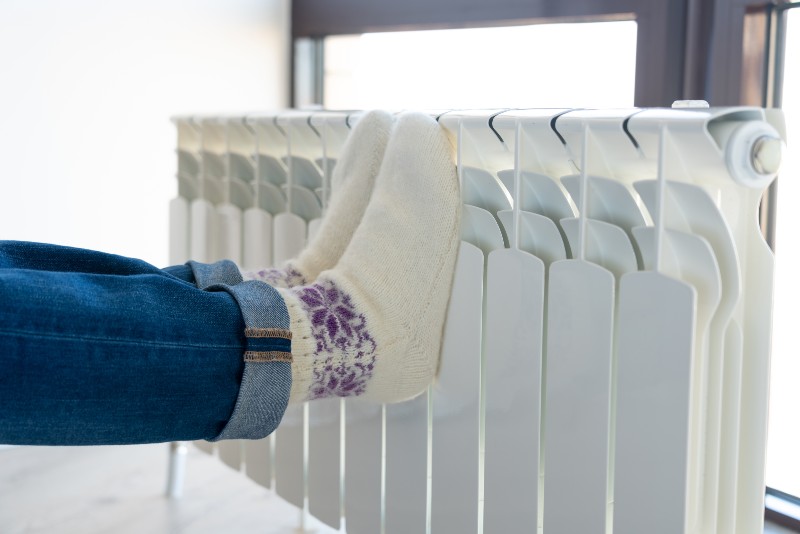It’s bad to find your heater is not working on a cold winter day, leaving you to put on extra clothes and figure out how to fix the problem.
Whether you’re trying to enjoy a cozy evening or just want to keep away the chill, a malfunctioning heater can disrupt your comfort and peace of mind.
As a homeowner, you may be able to resolve some common heater problems on your own before calling in a professional.
Here we’ll list the common 10 reasons why your heater may not be working and provide you with practical steps to diagnose and fix these issues.
1. Thermostat Issue
One of the first places to check when your heater won’t turn on is the thermostat. This small device controls the temperature settings in your home and directs your heating system accordingly. A malfunctioning thermostat can lead to miscommunication with your heating system, resulting in no heat.
Firstly, verify that the thermostat is set to “heat” and the temperature setting is higher than the current room temperature. If settings appear correct, the problem might lie within the thermostat’s internal wiring or its connection to the heater.
If your thermostat is battery-operated, consider replacing the batteries to rule out a simple power issue.
Sometimes, the issue could be with the circuit breaker tied to the heating system.
If the thermostat settings and batteries check out, go to your home’s electrical panel and locate the circuit breaker for the heating system. It may have tripped, cutting power to the thermostat and, subsequently, the heater.
Flip the breaker off and then on again to reset the connection. If the breaker repeatedly trips, this could indicate a deeper electrical problem, and you may need to consult with an electrician.
2. Clogged Air Filter
Your heater’s air filter plays a fundamental role in maintaining good air quality and ensuring efficient operation. Over time, filters accumulate dust and debris, which can severely restrict airflow.
When this happens, your heating system has to work harder to circulate warm air, which can lead to overheating and automatic shutdowns.
Inspect your air filter regularly, especially during peak usage months. If you notice a buildup of dirt and debris, it’s time to clean or replace the filter.
Most filters should be checked monthly and changed at least every three months, although some high-efficiency filters can last longer. A clean filter allows for optimal airflow, ensuring your heat pump or furnace doesn’t overheat and continues to run effectively.
If you can’t see light passing through the filter when you hold it up to a light source, it’s definitely time for a replacement.
3. Blocked Ducts
The warmth from your heater is distributed throughout your home via a network of ducts. However, if these ducts are blocked or partially closed, the flow of warm air is impeded, leading to uneven heating or, in some cases, no heating at all in certain areas of your home.
It’s quite common for furniture to accidentally block vents, or for vents to be closed without realizing the impact.
Take a walk through your home and make sure all the vents and registers are open and unobstructed. If you find some are closed, open them to promote proper airflow.
If the issue persists after checking all visible vents, the blockage could be within the ductwork itself—something as small as a toy or as problematic as a collapsed section of ducting.
Accessible blockages can sometimes be removed by homeowners, but more complicated situations may require a professional duct cleaning service. In addition to blockages, it’s also worth looking for signs of damage or leaks in your ductwork which can result in loss of heated air and reduced efficiency.
Sealing any leaks and insulating ducts can help ensure that all the heat produced by your furnace reaches the intended areas of your home without significant loss.
4. Condensate Pan Issues
Modern high-efficiency heaters often produce condensate, water that forms when the warm air from your furnace cools and condenses. This water is typically directed into a condensate pan and drained away.
However, if the pan gets full or the drain line becomes clogged, it can trigger an automatic shut-off to prevent water damage.
To address this, locate your system’s condensation pan—usually situated beneath the indoor part of your heater. If the pan is full of water, you’ll need to drain it.
After that, inspect the condensation drainage line for blockages, which may include dirt, algae, or ice in colder temperatures. Clearing the blockage and emptying the pan should allow the system to reset and start up again.
Make sure to also check for any signs of leaks around the condensation pan and drain line. Persistent water accumulations can lead to mold growth and property damage, so addressing leaks promptly is important.
If you’re uncomfortable performing these tasks or unsure how to proceed, don’t hesitate to contact a heating professional who can take care of the maintenance for you and provide tips on how to prevent future issues.
5. Lack of Maintenance
Regular maintenance is the key to a well-functioning heater. Ignoring routine checks can lead to a host of problems, including a furnace that refuses to start. Dirt accumulation on important components like the blower motor or flame sensor can impede their functionality and cause your system to shut down as a safety precaution.
The blower motor is responsible for pushing air through your heating system and into your home. If it’s coated in dust, it may struggle to push enough air, raising the temperature inside the furnace and tripping the high limit switch to prevent overheating.
Similarly, the flame sensor is a safety device that confirms whether a flame is present when the gas valve is open. If this sensor is covered in soot or corrosion, it may not detect the flame, leading to an automatic shutdown to avoid gas leaking into your home.
Routine inspections and cleanings can prevent these issues. Many HVAC companies offer annual maintenance service contracts that include cleaning critical components, checking
and tightening electrical connections, testing system controls, and ensuring the safety mechanisms are functioning correctly.
Between professional maintenance visits, make sure to keep the area around the heater clean and free from debris. This can help reduce the amount of dirt that gets inside the system and minimizes the potential for interruptions in service.
6. Check If Power Source Is On
It might seem like a no-brainer, but sometimes the simplest solutions are the most overlooked. If your heater is not working, ensure that it is, in fact, receiving power. For an electric furnace, this means checking that the switch is on. Most units have a dedicated switch, which can sometimes be turned off accidentally.
For those with a gas heater, make sure the gas valve is open and that your home isn’t experiencing a supply disruption.
If you’re unfamiliar with the gas supply valves or are not certain how to check the fuel levels (for propane or oil heaters), it’s better to call a qualified technician for help rather than trying to address it yourself and risking a gas leak or other hazards.
7. Dead Blower Capacitor
The blower capacitor is the component that provides the initial boost to turn on the blower motor and keeps it running. When a capacitor starts to fail, the furnace will often begin by
humming but won’t fully start, or it may start slowly and struggle to get up to speed. If you observe these symptoms, then a dead blower capacitor could be the culprit. This issue would require a replacement to restore the heater’s function.
Replacing a blower capacitor is typically a job for an HVAC professional, as it involves understanding electrical components and ensuring the correct capacitor is used. Also, handling capacitors can be dangerous due to the electrical charge they store, hence why a careful approach is imperative.
8. Malfunctioning Fuse Box
Your heating system is protected by fuses or circuit breakers at the electrical panel, and if a fuse has blown or a breaker has tripped, your heater will not receive power. You can easily check the fuse box for any signs of blown fuses, but remember, fuses must be handled carefully to avoid electrical shock.
If you do find a blown fuse, replace it with a new one that matches the required amperage. Keep in mind that fuses blow for a reason, often because of an overloaded circuit or a short within the heating system.
If new fuses continue to blow, it’s important to call an electrician or HVAC technician to diagnose and resolve the underlying issue.
9. Lack of Gas
If your heater is gas-powered, its function is heavily dependent on an uninterrupted gas supply. Should this supply be compromised or halted for any reason, your heater will cease to function. It’s paramount to check that the gas valve at the heater is open and in the proper position to allow gas to flow to the unit.
Keep in mind that if you smell gas or suspect a leak, you should not attempt to fix the problem yourself. Instead, evacuate the area and contact your gas company or a professional immediately from a safe location. Gas leaks can be extremely dangerous, leading to fire risks and exposure to harmful fumes.
10. Cracked Heat Exchanger
The heat exchanger in a furnace is critical to its operation. It separates the combustion process from the air circulating through your home. If a heat exchanger becomes cracked, it can lead to serious safety hazards, including the release of carbon monoxide into your living space, which is odorless and potentially lethal.
A cracked heat exchanger will require professional inspection and, more likely than not, replacement. This issue is not one that should be addressed by a layperson due to the serious risks involved and the complexity of the repair.
If your carbon monoxide detector goes off or you notice an unusual smell coming from your heater or symptoms of a headache, dizziness, or nausea that seem to occur when the heater is running, these could be signs of carbon monoxide poisoning, and you should act immediately.
Turn off the furnace, open windows to ventilate your home, and vacate the premises. Once you’re in a safe location, contact a certified HVAC technician to inspect your heater and confirm whether the heat exchanger—or any other component—is at fault.
Conclusion
Dealing with a non-functioning heater can be a source of stress and discomfort, especially during the chill of winter. If you can understand the most common reasons behind heating failures, you may take proactive steps to solve the issue by yourself.
Although some heater issues can be handled with some basic knowledge and quick troubleshooting, there are times when you should call a professional for assistance. If you’ve gone through the basic checks and fixes without any success, it could indicate a more intricate problem that requires a professional diagnosis.
Complex repairs, such as dealing with gas lines, electrical repairs beyond resetting a circuit breaker, or replacing a heat exchanger, are best left to the expertise of a certified technician.





